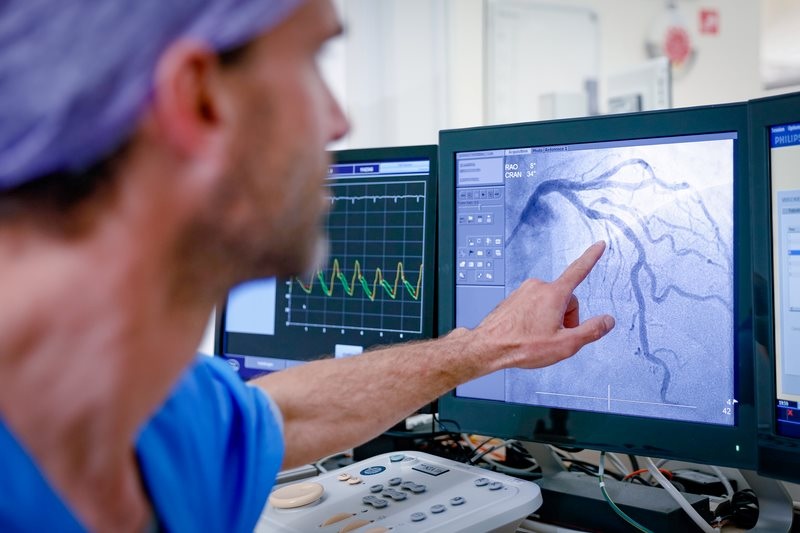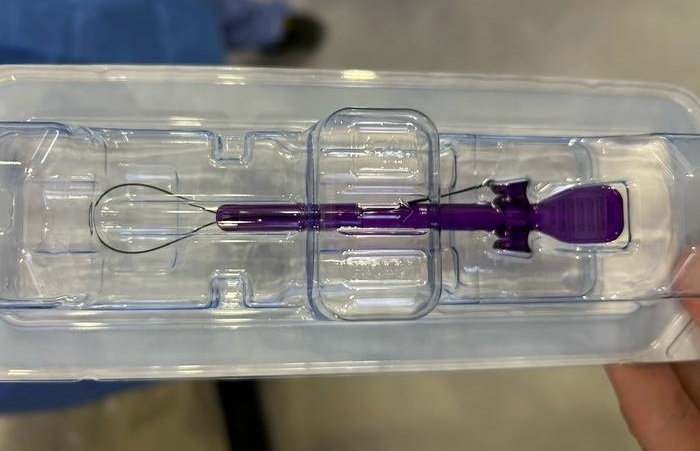Electronic Devices May Contribute to Carpal Tunnel Syndrome
|
By HospiMedica International staff writers Posted on 05 Jul 2017 |
Intensive users of handheld electronic devices suffer more wrist and hand pain than non-intensive users, according to a new study.
Researches at Hong Kong Polytechnic University (Kowloon, China) conducted a study among 48 university students, half of them intensive users (over five hours a day of interaction with electronic devices), and half of them non-intensive users (less than five hours a day of electronic devices usage). Study participants filled in a questionnaire, completed provocative tests, and underwent ultrasonic measurement of carpal tunnel morphological parameters. All participants were right-handed.
The results showed that intensive users had significantly more positive results in Phalen's and Durkan's tests and reported more wrist and hand pain than non-intensive users. They also had significantly larger median nerve cross-sectional areas, flattening ratios, and perimeters, as well as greater bowing of the transverse carpal ligament compared with non-intensive users, resulting in numbness, tingling, and pain in the hand. The study was published on June 21, 2017, in Muscle & Nerve.
“Our prior work identified that out of 500 students, 54% of intensive users and 12% non-intensive users reported musculoskeletal symptoms in relation to use of electronic devices. We randomly selected 48 students for further investigation, and our results showed that excessive use of electronic devices may be linked to a greater risk of developing carpal tunnel syndrome,” said study author Peter White, PhD. “Therefore, vigilance in educating and monitoring young people using electronic devices is important, especially children and adolescents, as they are less capable of self-regulating.”
Carpal tunnel syndrome is a median entrapment neuropathy that causes paresthesia, pain, numbness, and other symptoms in the distribution of the median nerve. It appears to be caused by a combination of genetic and environmental factors, including diabetes, pregnancy, obesity, hypothyroidism, and heavy manual work or work with vibrating tools. Other disorders such as bursitis and tendinitis have been associated with repeated motions performed in the course of normal work or other activities.
Related Links:
Hong Kong Polytechnic University
Researches at Hong Kong Polytechnic University (Kowloon, China) conducted a study among 48 university students, half of them intensive users (over five hours a day of interaction with electronic devices), and half of them non-intensive users (less than five hours a day of electronic devices usage). Study participants filled in a questionnaire, completed provocative tests, and underwent ultrasonic measurement of carpal tunnel morphological parameters. All participants were right-handed.
The results showed that intensive users had significantly more positive results in Phalen's and Durkan's tests and reported more wrist and hand pain than non-intensive users. They also had significantly larger median nerve cross-sectional areas, flattening ratios, and perimeters, as well as greater bowing of the transverse carpal ligament compared with non-intensive users, resulting in numbness, tingling, and pain in the hand. The study was published on June 21, 2017, in Muscle & Nerve.
“Our prior work identified that out of 500 students, 54% of intensive users and 12% non-intensive users reported musculoskeletal symptoms in relation to use of electronic devices. We randomly selected 48 students for further investigation, and our results showed that excessive use of electronic devices may be linked to a greater risk of developing carpal tunnel syndrome,” said study author Peter White, PhD. “Therefore, vigilance in educating and monitoring young people using electronic devices is important, especially children and adolescents, as they are less capable of self-regulating.”
Carpal tunnel syndrome is a median entrapment neuropathy that causes paresthesia, pain, numbness, and other symptoms in the distribution of the median nerve. It appears to be caused by a combination of genetic and environmental factors, including diabetes, pregnancy, obesity, hypothyroidism, and heavy manual work or work with vibrating tools. Other disorders such as bursitis and tendinitis have been associated with repeated motions performed in the course of normal work or other activities.
Related Links:
Hong Kong Polytechnic University
Latest Critical Care News
- EEG-Based AI Technology Accurately Diagnoses Alzheimer’s and Dementia
- Robot Lymphatic System Paves Way for Self-Powered Wearables and Machines
- Focused Ultrasound Technique Successfully Treats Pediatric Brain Cancer
- Nasal Drops Fight Brain Tumors Noninvasively
- AI Helps Optimize Therapy Selection and Dosing for Septic Shock
- Glowing Bacteria ‘Pills’ for Detecting Gut Diseases Could Eliminate Colonoscopies
- Skin-Permeable Polymer Patch Delivers Insulin Non-Invasively Through Skin
- Nanogel Technology Almost 100% Effective in Destroying Drug-Resistant Bacteria Within Hours
- Wearable Ultrasound Sensor Delivers Noninvasive Treatment Without Surgery
- Gel-Free ECG System to Transform Heart Health Diagnosis
- Biodegradable Patch Repairs Damaged Tissue After Heart Attack
- Magnetically Guided Microrobots to Enable Targeted Drug Delivery

- Smart Nanomaterials Detect and Treat Traumatic Brain Injuries Simultaneously
- Earlier Blood Transfusion Could Reduce Heart Failure and Arrhythmia in Heart Disease Patients
- 'Smart' Shirt Detects Epileptic Seizures in Real Time
- Skin Patch Measures Effectiveness of Flu/COVID Vaccines in 10 Minutes
Channels
Surgical Techniques
view channelLaparoscopic Surgery Improves Outcomes for Severe Newborn Liver Disease
Biliary atresia is a rare but life-threatening liver condition in newborns that blocks bile flow and leads to progressive liver damage if not treated early. Surgery is typically performed within the first... Read moreNovel Endoscopy Technique Provides Access to Deep Lung Tumors
Detecting lung cancer early can save lives, but diagnosing small tumors deep in the outer regions of the lungs remains a major clinical challenge. Although CT scans frequently identify tiny suspicious... Read morePatient Care
view channel
Revolutionary Automatic IV-Line Flushing Device to Enhance Infusion Care
More than 80% of in-hospital patients receive intravenous (IV) therapy. Every dose of IV medicine delivered in a small volume (<250 mL) infusion bag should be followed by subsequent flushing to ensure... Read more
VR Training Tool Combats Contamination of Portable Medical Equipment
Healthcare-associated infections (HAIs) impact one in every 31 patients, cause nearly 100,000 deaths each year, and cost USD 28.4 billion in direct medical expenses. Notably, up to 75% of these infections... Read more
Portable Biosensor Platform to Reduce Hospital-Acquired Infections
Approximately 4 million patients in the European Union acquire healthcare-associated infections (HAIs) or nosocomial infections each year, with around 37,000 deaths directly resulting from these infections,... Read moreFirst-Of-Its-Kind Portable Germicidal Light Technology Disinfects High-Touch Clinical Surfaces in Seconds
Reducing healthcare-acquired infections (HAIs) remains a pressing issue within global healthcare systems. In the United States alone, 1.7 million patients contract HAIs annually, leading to approximately... Read moreHealth IT
view channel
EMR-Based Tool Predicts Graft Failure After Kidney Transplant
Kidney transplantation offers patients with end-stage kidney disease longer survival and better quality of life than dialysis, yet graft failure remains a major challenge. Although a successful transplant... Read more
Printable Molecule-Selective Nanoparticles Enable Mass Production of Wearable Biosensors
The future of medicine is likely to focus on the personalization of healthcare—understanding exactly what an individual requires and delivering the appropriate combination of nutrients, metabolites, and... Read moreBusiness
view channel
Philips and Masimo Partner to Advance Patient Monitoring Measurement Technologies
Royal Philips (Amsterdam, Netherlands) and Masimo (Irvine, California, USA) have renewed their multi-year strategic collaboration, combining Philips’ expertise in patient monitoring with Masimo’s noninvasive... Read more
B. Braun Acquires Digital Microsurgery Company True Digital Surgery
The high-end microsurgery market in neurosurgery, spine, and ENT is undergoing a significant transformation. Traditional analog microscopes are giving way to digital exoscopes, which provide improved visualization,... Read more
CMEF 2025 to Promote Holistic and High-Quality Development of Medical and Health Industry
The 92nd China International Medical Equipment Fair (CMEF 2025) Autumn Exhibition is scheduled to be held from September 26 to 29 at the China Import and Export Fair Complex (Canton Fair Complex) in Guangzhou.... Read more















